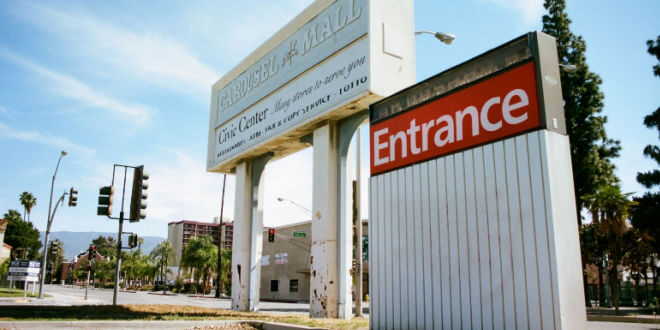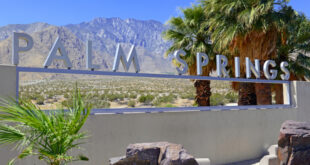Jim Mulvihill, who represented San Bernardino’s seventh ward from 2013 to 2020, attended the mall’s demolition ceremony on April 24 and said afterward that he approved of what he saw, and what the city wants to do with the 43-acre downtown site.
“Ten years from now, I think you’ll see a nice mixed-use project on that site: a commercial, residential, and office development that is the hub of a vibrant, revenue-generating downtown. “I’m very optimistic.”
Mulvihill, a part-time instructor of urban planning at Cal State San Bernardino, advocated leveling the mall while he was on the council. He spoke with IE Business Daily about why the mall failed and why it was so difficult for the city to agree to demolish the mall and start from scratch.
His remarks have been edited for clarity.
Q: What were your thoughts on the demolition ceremony? After so many years it must have been gratifying to finally see something happen.
A: It was, but after all this time it was kind of anti-climactic. I guess my strongest feeling is that I wish it had happened sooner. This issue of restoring the Carousel Mall, or tearing down the mall and doing something with the property, goes back about 20 years. We were asked about it all of the time when I was on the council.
Q: In what way?
A: People wanted to know what we were going to do with it, but they also wanted to know why we had to deal with the problem in the first place. I was on a panel at the Southern California Association of Governments about five years ago, and it was all anyone wanted to talk about. The people who weren’t familiar with San Bernardino couldn’t believe we had an abandoned mall in the heart of downtown. It’s odd to have that much property available for development. They viewed it as an opportunity, and one person in particular at that conference saw its potential.
Q: Who?
A: Don Monti [president and chief executive officer of Renaissance Downtown, one of two developers selected by the city to revive the mall property]. He was at that conference, and he told me that if the city ever decided to fix up the Carousel Mall, to give him a call.
Q: But why did It languish for so long? By the late 1990s, attendance was down, specialty tenants were leaving and it was losing anchor tenants. Montgomery Ward shut down in 2000 when the entire chain went out of business, and JC Penney left three years later.
A: I think there were several reasons. The economy collapsed in 2008, and the city filed for bankruptcy in 2012. The bankruptcy took 10 years to resolve. The city couldn’t agree on whether to tear It down. That was the main thing. I was one of the first [council members] who said it needed to be torn down, but some people had a difficult time making that decision. We also don’t have redevelopment anymore, which the state did away within 2012. If we still had redevelopment, it would have been easier to do something with that property.
Q: So there was no consensus on the council regarding what should be done?
A; No. Mayor Holcomb [the late William Robert Holcomb, who served as mayor from 1971 to 1985 and 1989 to 1993] wanted to do a major redevelopment project near where the Caltrans building is now [464 W. 4th St. in the Rosa Parks Memorial Building]. It was going to be massive, like a 1950s-era redevelopment project, where entire blocks would have been removed. Maybe that wasn’t a bad idea, but should that have been a higher priority than a major piece of property downtown? I didn’t think so.
Q: Was there a time when you felt like the mall was beyond saving?
A: Yes, when JC Penney left. At that point knew I it was pretty much dead.
Q: Carousel Mall barely turned a profit in its best days. Why didn’t it perform better?
A: I think it was because the Inland Center Mall was already here. It opened in 1966, and it did well, and there was no room for a second regional mall in downtown San Bernardino. The Carousel Mall probably never should have been built.
Q: In retrospect, you don’t think it could have succeeded?
A: In 1964, the city had a market study done that concluded that, in three years, the local economy would be able to support a mall that would cover 610,800 square feet. Inland Center Mall opened in 1966, and it covered 821,500 square feet. The analysis said that building a second mall would be a “questionable venture.”
Q: But they ended up building it anyway.
A: Yes. The San Bernardino Redevelopment Agency set up what they called the Central City No. 1 Project, which was the plan for a two-story mall and a civic center complex. It was a very unusual project from the start because it was funded entirely by the city. There was no private investment, which doesn’t happen very often with a project that size.
Q: Did the mall have a design flaw that kept it from succeeding?
A: No, the flaw was economic. The city paid for the entire project, and then it was paying $1 million a year for maintenance and security. Ultimately, though, it was supply and demand. There wasn’t enough demand for two regional shopping malls in San Bernardino.
Q: Last month, the city learned that its redevelopment plans for the Carousel Mall violated several state laws, including a breach of the state’s surplus land act and not allowing for enough affordable housing within the project.
A: I hope those things are worked out, and I think they will. The city has made a lot of mistakes regarding Carousel Mall, but it had to know about the state’s affordable housing requirement. The problem is that the land downtown is so expensive. Developers who build affordable housing have to find inexpensive land, and they won’t find it downtown.
Q: How important is the restoration of that property for the city’s economic future?
A: It’s absolutely essential. San Bernardino doesn’t have a lot of economic opportunities, but the Carousel Mall site is a huge one. About 15,000 people work in downtown San Bernardino, so what they want to build there should work. I’m optimistic because I don’t know what else the city could do with that site.
 IE Business Daily Business news for the Inland Empire.
IE Business Daily Business news for the Inland Empire.


